A team of researchers working at SSRL Beam Line 13-3 have devised an imaging
technique that combines methods from traditional x-ray crystallography and
x-ray holography, circumventing one of the major technical hurdles associated
with capturing detailed images of non-periodic structures. The results were
published in the August 15 edition of Physical Review Letters.
X-ray diffraction has been widely used to determine the structure of
macromolecules like proteins, but samples must first be grown into a crystal
where the molecules are arranged in a periodic pattern. The regular ordering of
the molecules in the sample makes it much easier to recover information about
the phase of the diffracted x-rays, which then enables researchers to recreate
the structure of the molecules in the sample.
The desire to image all kinds of natural and artificial nanostructures or
materials that exhibit nanoscale ordering has led to the development of x-ray
imaging techniques that do not rely on any form of sample periodicity. One such
method is real space x-ray microscopy by use of suitable x-ray lenses. Other
"lensless" methods use coherent x-ray scattering, however the reciprocal space
"speckle" pattern needs to be inverted into real space. This step is impeded by
the famous "phase problem", which in the past has been overcome by MAD
techniques or holographic methods. The SSRL researchers found a new way to
solve the phase problem by capturing two scattering patterns of a sample-in
this case, microscopic polystyrene beads on a specially prepared thin
film-using coherent x-rays of two different energies. A "resonant" beam at the
carbon K edge (285 eV) was used obtain a diffraction pattern that highlighted
the carbon atoms in the sample, along with a "non-resonant" beam used to
capture a baseline diffraction pattern as a reference. The two images were then
combined, allowing the researchers to recover the phase information and
recreate a two-dimensional image of the sample. The ability to capture detailed
images of non-periodic structures holds great promise for imaging all kinds of
nanostructures which in most cases are not periodic.
To learn more about this research see the full scientific highlight at:
http://www-ssrl.slac.stanford.edu/research/highlights_archive/lensless_MAD.html
2. Science Highlight —
Small, Fast, and Holographic
(contact: W. Schlotter, william.schlotter@desy.de)
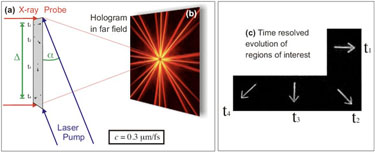 | |
| Proposed ultrafast stop watch
| |
Panoramic images are captivating in any form, with their wide field of view and
extremely high resolution. Now, SSRL scientists have demonstrated a new x-ray
holographic technique for imaging wide areas of a nanoscale sample without
losing resolution. The results were published in the November 2007 edition of
the journal Optics Letters.
A similar technique was first demonstrated at Stanford over 50 years ago using
light of visible wavelengths as a means of improving holographic images
distorted by atmospheric disturbances. With x-rays, however, it is the finite
size of the pixels in the detector that blurs resolution, which in a hologram
translates to a smaller field of view in the reconstructed image. To overcome
this limitation, the team strategically arranged a collection of reference
points on the sample to increase the effective field of view, which counters
the smearing otherwise caused by the detector.
The team used the soft x-ray coherent scattering capabilities of Beam Line 5-2
(which has now been moved to a new location and is BL13-3) to image a
nanostructured, 1 micron-thick gold film sample. Four individual arrow shapes
spanning one fifth of a millimeter were milled through the film, with a
strategically placed reference point next to each arrow. The reconstructed
image successfully showed all four arrows with 50-nanometer resolution.
The new technique could also prove particularly useful for studying ultrafast
processes using x-ray free electron lasers such as the Linac Coherent Light
Source.
To learn more about this research see the full scientific highlight at:
http://www-ssrl.slac.stanford.edu/research/highlights_archive/extended_FTH.html
3.
Ajay Virkar to Receive 2008 Klein Professional Development Award
| 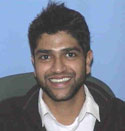 |
Congratulations to Ajay Virkar, a graduate student in the Department of
Chemical Engineering at Stanford University. He will receive the Melvin P.
Klein Professional Development Award for his 'extraordinary progress towards
the basic understanding of organic semiconductor growth behavior.' The Klein
Award, which includes a certificate and $1,000, recognizes a graduate or
undergraduate student for outstanding research using SSRL facilities. Virkar
plans to present his work during the Young Investigators Session at the
SSRL/LCLS Annual Users' Meeting on October 16, as well as at an international
conference on material science next year.
Optimizing performance in organic semiconductor thin films is necessary for
realizing the potential of organic (plastic) electronics which seek to bring a
new era of inexpensive, flexible displays, radio frequency ID tags and sensors.
In organic, or carbon based, semiconducting thin films the performance (how
fast charge can be passed) is dominated by the morphology. Using grazing
incidence x-ray diffraction (GIXD) in collaboration with Michael Toney (SSRL),
Virkar was able to study the sensitivity of organic thin film growth and
crystallinity to very small changes in the nature of the surface on which they
are deposited. These findings have made significant contributions to optimizing
organic thin films for next generation flexible electronics. Virkar also
demonstrated how sample preparation and experimental setup effects can often
dominate the obtained results, findings that will greatly benefit the field of
thin film material science.
"I think the success of this project in such a short time had a lot to do with
Ajay's persistence, patience, careful observation, intelligence and genuine
interest in finding answers to scientific problems," said Zhenan Bao, Associate
Professor of Chemical Engineering at Stanford.
4.
How Plants Do It: Light, Oxygen, Action!
(contact: U. Bergmann, bergmann@slac.stanford.edu)
 | |
|
|
On Tuesday, August 26 Vittal Yachandra (Lawrence Berkeley National Laboratory)
gave a SLAC Public Lecture on photosynthesis. Photosynthesis is the way by
which plants use sunlight to generate energy. In the process, they also use
water to create oxygen, which is critical to life on earth. Oxygen created by
the first primitive photosynthetic bacteria, transformed the earth, and made
complex life as we know it possible. In this lecture, Yachandra described the
evolution of photosynthesis and how understanding this process may help in the
development of artificial systems to reduce dependence on fossil fuels and
combat global warming. See SSRL science highlight at:
http://www-ssrl.slac.stanford.edu/research/psii-06_summary.html
5.
Call for User Science Poster Abstracts for Joint SSRL/LCLS Users' Meeting and
Workshops, October 15-18, 2008
(contact: C. Knotts, knotts@slac.stanford.edu)
Register to participate in the annual conference and share the results of your
recent experiments during the user science poster session on Thursday, October
16. Encourage your students to give a poster presentation (registration is
discounted for students, and dinner is free for students who present a
poster!). Users must be registered and abstracts submitted by September 5 to be
included in the printed program materials. The annual Users' Meeting is a
valuable opportunity to learn about the latest plans, new developments and
exciting user research at SSRL and LCLS. It is also a great time to interact
with other scientists, potential colleagues, staff and vendors of light
source-related products and services (and, if construction and utilities are
completed by early October, we plan to hold the poster session and dinner in
the new LCLS Experimental Hall!). Help us to publicize the annual conference by
forwarding this notice or posting the conference poster in your work areas.
http://www-conf.slac.stanford.edu/ssrl-lcls/2008/lclsssrl08_poster1.pdf
http://www-conf.slac.stanford.edu/ssrl-lcls/2008/
6.
Users Needed to Serve on the SSRL Users' Organization Executive Committee
(contact: R. Szilagyi, szilagyi@montana.edu)
The SSRL Users' Organization Executive Committee (SSRLUOEC) needs users who are
eager to get more involved in activities at SSRL. SSRLUOEC members represent
the entire user community and interact with management to help shape strategic
plans and prepare for future opportunities like PEP-X
http://www-ssrl.slac.stanford.edu/pep-x/.
We meet several times a year to
discuss issues of interest to users, promote user outreach, coordinate periodic
user surveys (see 2008 survey results
http://www-ssrl.slac.stanford.edu/users/ssrluo/2008usersurveyresults.pdf
),
organize the annual users' conference and workshops
http://www-conf.slac.stanford.edu/ssrl-lcls/2008/default.asp, and recognize outstanding scientific or technical accomplishments through awards
http://www-conf.slac.stanford.edu/ssrl-lcls/2008/awards.asp. The
SSRLUOEC also
coordinates activities with representatives from other DOE user facilities to
promote and sustain support for basic sciences as well as user facilities such
as SSRL to numerous constituencies. SSRLUOEC members serve a three-year term,
with the exception of the person elected Chair, who will serve on the committee
two additional years to facilitate continuity of SSRLUOEC activities.
http://www-conf.slac.stanford.edu/ssrl-lcls/2008/
If this sounds like something that interests you, or perhaps a colleague,
submit your nomination by September 29. http://www-conf.slac.stanford.edu/ssrl-lcls/2008/nominationForm.asp
Ballots will be collected electronically October 1-15.
http://www-conf.slac.stanford.edu/ssrl-lcls/2008/nominations.asp.
We look forward to welcoming you to the SSRL Users' Organization.
7.
Accelerator Physics Update on 500-mA Operations
(contact: J. Schmerge, schmerge@slac.stanford.edu)
For future SPEAR3 operation at 500 mA with top-off injection it is desirable to
inject with a high charge per bunch to minimize both the number of injected
bunches required to keep the current constant and the time required to fill the
ring from scratch when beam is lost. During the FY08 run the maximum injection
rate using the microwave cavity gun with thermionic cathode was 30 mA/min but
the goal for 500 mA operation is 100 mA/min. An experiment was conducted on
August 11 shortly after user operations ceased to test the SPEAR3 injector
maximum injection rate using photoemission instead of thermionic emission to
generate the electron beam. A laser was borrowed from LCLS to generate the
electron beam and after aligning onto the cathode the maximum measured
injection rate was 67 mA/min - although the number of electrons generated at
the cathode increase by a factor of four. This is a significant increase over
the normal injection rate, however, it is still below the goal because a large
fraction of the electrons are lost in the injector. Part of the work planned
for this shutdown is intended to improve the transmission through the injector
which will help increase the injection rate. Additional experiments will be
conducted during the Accelerator Physics periods next run to optimize the
injector for maximum injection rate.
8.
Updates to the Microprobe at BL2-3
(contact: S. Webb, sam.webb@slac.stanford.edu)
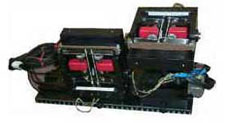 |
| Hard x-ray
microprobe |
During the run which ended in early August, part of the BL2-3 microprobe beam
time was dedicated to commissioning new beam line equipment including a
new Canberra 3-element Ge monolith detector, a Princeton Instruments CCD
detector for microdiffraction, and a phi-rotation stage. There has been a very
positive reception of the new capabilities, with one recent user remarking "We
wanted to test the data quality of our samples at Beam Line 2-3 (microfocus) in
comparison to other similar beam lines around the world. One huge advantage at
this beam line at SSRL was the energy range where we were able to get good
spectra for uranium, which is impossible to achieve at other beam lines. We
were able to get oxidation state maps for U(IV) and U(IV) and correlation plots
with other elements at 1 micron resolution for our samples, which were mine
tailings."
The SSRL facility produces a 1 to 2 micron spot size containing
~2x108
photons/sec. Experimental capabilities include x-ray fluorescence mapping,
micro x-ray absorption spectroscopy, micro x-ray diffraction and micro x-ray
tomography. The microprobe is optimized for the energy range 15 to 23 keV for
actinide experiments, but it has been used extensively at lower energies for a
multitude of disciplines, ranging from biology to material science. For the
2008-09 user run, the microprobe will be installed permanently in the BL2-3
hutch.
If you are interested in submitting new proposals for microprobe experiments at
BL2-3, remember that new X-ray/VUV proposals are due by November 1.
http://www-ssrl.slac.stanford.edu/users/user_admin/xray_vuv_proposal_guide.html.
Users with active proposals can request microprobe beam time for the next
scheduling period by submitting a beam time request by the September 5
deadline. https://www-ssrl.slac.stanford.edu/URAWI/Login.html
. Rapid Access
proposals for BL2-3 are also available.
http://www-ssrl.slac.stanford.edu/users/user_admin/bl2-3_microprobe_rapidaccess.html
.
Contact Sam Webb with questions about the microprobe equipment, sample
preparation, or data analysis.
9.
LCLS Experiment Proposal Deadline and Developments
Call for LCLS AMO Proposals - Due by September 1,
2008
(contact: J. Bozek, jdbozek@slac.stanford.edu)
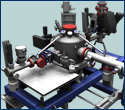 | |
| AMO Diagnostics Chamber
| |
font face="verdana,arial,helvetica,sans-serif" size="-1">
The world's first hard x-ray free-electron laser, the Linac Coherent Light
Source (LCLS), will produce intense, subpicosecond pulses of spatially-coherent
x-rays. In a flash of about 100 femtoseconds duration, LCLS will provide
1012
x-ray photons, roughly as many photons as obtained in one second at today's
best storage ring-based synchrotron radiation facilities. LCLS x-rays will
enable investigation of systems at the atomic and nanoscale under conditions
where the matter is far from equilibrium, and actually undergoing real-time
reactions.
Four experimental stations are currently being constructed to serve the
following scientific thrust areas: Atomic, molecular and optical science (AMO);
Coherent imaging of non-periodic objects (CXI); Coherent scattering of
nanoscale fluctuations (XCS); Diffraction studies of stimulated dynamics (XPP).
Two more stations are currently being planned to serve: High energy density
science (HED); and Investigation of materials with soft x-rays (SXR). It is the
goal of LCLS to attract a large number of users from diverse fields and to
enable a broad set of important experiments that take advantage of the unique
capabilities of LCLS.
LCLS will begin operation in the second half of 2009, providing x-rays in the
spectral range 0.8 to 2 keV. The AMO experimental station will be ready for
commissioning and first operation during this period. LCLS invites the world's
research community to submit scientific proposals by September 1, 2008 for
experiments with soft x-rays at the AMO experimental station for the LCLS
operation period July-December 2009. http://lcls.slac.stanford.edu/user/
During 2010 it is anticipated that the spectral range of the LCLS will be
extended to 8 keV. Learn more about plans for the LCLS at the annual
conference.
http://www-conf.slac.stanford.edu/ssrl-lcls/2008/
http://lcls.slac.stanford.edu
LUSI Project Completes Critical Decision 2 Review
SLAC Today article by Brad Plummer
 |
|
X-ray Pump-Probe Instrument (XPP)
|
Congratulations to the scientists and engineers of the Linac Coherent Light
Source Ultrafast Science Instrumentation project, or LUSI. The team last week
successfully completed Department of Energy review for Critical Decision 2, or
CD2. This is a huge milestone for the group and for the LCLS collaboration as a
whole, giving the green light for instrument designs and cost estimates.
"I'm sure the LUSI team feels pretty good right now. You've earned it," said
LCLS director of construction John Galayda during the review closeout session
last Thursday. SLAC Director Persis Drell thanked the DOE review panel and
offered her congratulations to the LUSI team. "I'm really proud of how this has
come together. The laboratory thanks you for your efforts." The three-day
review took place to evaluate the scientific program underlying the LUSI
project, as well as the data collection, control and safety systems associated
with the instruments. The LUSI project comprises an initial set of three
instruments, to be built by 2012, for use with the LCLS: X-ray Correlation
Spectroscopy, X-ray Pump Probe and Coherent X-ray Imaging. Future additions
will include instruments for high energy density science and soft x-ray
materials science.
10.
SSRL Celebrates Another Successful Run
| 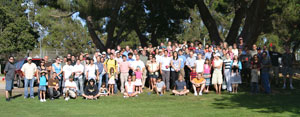 |
|
|
For about the last 30 years, staff at the Stanford Synchrotron Radiation
Laboratory (SSRL) have held a gathering to celebrate the end of each user run
(users are usually at SSRL conducting experiments November through August).
This year about 200 people from SSRL along with colleagues from the LCLS and
Photon Sciences Directorates (and their families) joined together last Friday
at Mitchell Park in Palo Alto. Ben Poling and friends prepared a delicious
barbecue dinner which included pork, hamburgers, veggie burgers, polish hot
dogs, baked beans, chips, cookies, and a variety of drinks. Staff talked,
laughed, met each others' families and pets, played volleyball, practiced their
golf chipping skills, and generally relaxed and had a good time. SSRL Director
Jo Stöhr thanked the event organizers, and acknowledged the dedication and hard
work of the SSRL staff and thanked their families for support. For yet another
run, the SSRL staff enabled the users to successfully complete their
experiments.
11.
User Research Administration Update
(contact: C. Knotts, knotts@slac.stanford.edu)
— X-ray/VUV Beam Time Requests Due September 5
Submit your beam time requests for the first scheduling period for the 2008-09
run (~mid November-mid February) by September 5 using our new web interface.
This new system will assist you in keeping track of your active proposals and
submitting your beam time requests (you can view or copy past requests as
well). To register or to request a password, just log in to
https://www-ssrl.slac.stanford.edu/URAWI/Login.html
X-ray/VUV Beam Line Update: BL5-1 (PES, NEXAFS) and BL5-2 (Coherent Scattering)
have been upgraded and relocated to BL13-2 and BL13-3, respectively; we
anticipate that these stations will be available for users in December (after
commissioning in the fall). The Beam Line 4 upgrade is complete and
commissioning is scheduled for the fall. We anticipate that BL4-2 (BioSAXS)
will be ready for users in December, and BL4-1 (XAS) and BL4-3 (XAS) ready for
users in January. For more information about SSRL beam lines, see
http://www-ssrl.slac.stanford.edu/beamlines/
— End of Run Surveys Needed for Experiments in
2007-08
If you have already returned an End of Run Summary form for your beam time at
SSRL during the run which ended in early August, thank you! If you have not yet
done so, please submit a survey for each of your scheduled experiments at your
earliest convenience (we need your feedback after each experiment is conducted,
even if on multiple beam lines or proposals). Your comments and suggestions
help us to improve our user services and provide feedback needed for various
DOE reports.
http://www-ssrl.slac.stanford.edu/users/user_admin/form_ers.html
— Fresh New Look for SSRL Website
The SSRL website (http://www-ssrl.slac.stanford.edu/) is being transformed to
give more visibility to news and events and to facilitate links to user
services, facilities, science and general SSRL information. We hope that the
new site better meets the needs of users and staff, and we welcome your input
as the site continues its transformation. Stay tuned ...
__________________________________________________________________________
SSRL Headlines is published electronically monthly to inform SSRL users,
sponsors and other interested people about happenings at SSRL. SSRL is a
national synchrotron user facility operated by Stanford University for the
U.S. Department of Energy Office of Basic Energy
Sciences. Additional support for
the structural biology program is provided by
the DOE
Office of Biological and Environmental Research, the NIH
National Center for Research Resources and the NIH Institute for General Medical
Sciences. Additional information about
SSRL and its operation and schedules is available from the SSRL WWW
site.
__________________________________________________________________________
To leave the SSRL-HEADLINES distribution, send email as shown below:
To: LISTSERV@SSRL.SLAC.STANFORD.EDU
Subject: (blank, or anything you like)
The message body should read
SIGNOFF SSRL-HEADLINES
That's all it takes. (If we have an old email address for you that is
forwarded to your current address, the system may not recognize who
should be unsubscribed. In that case please write to
ssrl-headlines-request@ssrl.slac.stanford.edu and we'll try to figure out
who you are so that you can be unsubscribed.)
If a colleague would like to subscribe to the list, he or she should send
To: LISTSERV@SSRL.SLAC.STANFORD.EDU and use the message body
SUBSCRIBE SSRL-HEADLINES








